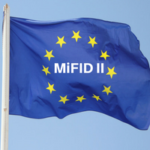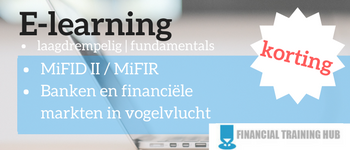Is uw organisatie klaar voor MiFID II? – E-learning uitgelicht
| 08-11-2017 | Financial Training Hub |
 Na de vorming van de euro is het toezicht op financiële instellingen en markten geïnternationaliseerd. Hierbij is het logisch om een ‘level playing field’ binnen de eurozone te realiseren om reguleringsarbitrage te voorkomen.
Na de vorming van de euro is het toezicht op financiële instellingen en markten geïnternationaliseerd. Hierbij is het logisch om een ‘level playing field’ binnen de eurozone te realiseren om reguleringsarbitrage te voorkomen.
De vorming van een level playing field voor het prudentieel toezicht op financiële instellingen vindt plaats via de Bazelse akkoorden en Solvency regelgeving. Prudentieel toezicht heeft als doel om financiële instellingen gezond te houden en faillissement te voorkomen door bedrijfseconomische oorzaken. Naast prudentieel toezicht is er ook gedragstoezicht dat is gericht op de bescherming van beleggers, bijvoorbeeld bij de handel in financiële producten op de beurs. Dit gedragstoezicht is sinds 2007 vastgelegd in Europese regelgeving via de Markets in Financial Instruments Directive (MiFID).
De politiek heeft sinds begin jaren ’80 de regulering van het financieel stelsel gebaseerd op het principe van vrije marktwerking. Op basis van dit principe kregen financiële instellingen steeds meer ruimte om hun activiteiten te ontplooien onder de veronderstelling dat markten voldoende zelfregulerend vermogen hebben om het nemen van onverantwoorde risico’s te voorkomen. Tijdens deze periode globaliseerde de financiële sector snel, nam de groei van de kredietverlening en derivatenhandel sterk toe en ontstonden er zeer grote too-big-to-fail systeembanken. Too-big-to-fail betekent dat faillissement van een dergelijke systeembank het totale financiële systeem destabiliseert met mogelijk ernstige negatieve economische gevolgen zoals gebeurde na de beurscrash van 1929. Tegelijkertijd groeide de licht gereguleerde schaduwbanksector in hoog tempo. Financiële instellingen binnen deze sector, zoals hedge funds, kunnen meer risico’s nemen om hogere rendementen na te streven.
Uit een groot aantal calamiteiten is gebleken dat toezichthouders niet meer adequaat konden ingrijpen bij de toenemende vrije marktwerking en dat zelfregulering onvoldoende plaats vond. Er zijn bijvoorbeeld een groot aantal nieuwe financiële producten ontwikkeld en verkocht die veel klanten in problemen hebben gebracht. Voorbeelden van deze producten in Nederland zijn: aandelenlease, woekerpolissen, tophypotheken en MKB renteswaps. Daarnaast manipuleerden handelaren op de financiële markten rente- en valutabenchmarks om voordeel te behalen: Libor (rente) en W/M Reuters (valuta). Uiteindelijk bleek tijdens de kredietcrisis van september 2008 na het faillissement van Lehmann Brothers, dat systeembanken bedrijfseconomisch fragiel waren geworden door het nemen van grote risico’s om hoog rendement te kunnen behalen. Hierdoor hebben overheden en centrale banken ongekende interventies moeten uitvoeren om een ineenstorting van het financiële stelsel te voorkomen.
Door deze kredietcrisis is het politieke klimaat gekeerd en is op basis van strengere regelgeving het toezicht geïntensiveerd. Naast introductie van strengere regels voor prudentieel toezicht, wordt ook het gedragstoezicht aangepast met de invoering van de Europese MiFID II per 3 januari 2018. MiFID II geeft de Autoriteit Financiële Markten (AFM) aanzienlijk meer bevoegdheid om te interveniëren en sancties op te leggen, vooral op het terrein van corporate governance, product governance en product intervention.
Vanwege de omvang en complexiteit is de impact van MiFID II binnen de financiële sector voor veel instellingen nog onduidelijk. Deze instellingen doen er verstandig aan om hoge prioriteit te geven om MiFID II-compliant te worden om interventies of sancties van de toezichthouder te voorkomen.
E-learning: MiFID II / MiFIR
Deze e-learning introduceert deelnemers in het Europese financiële toezicht en de in 2018 ingaande MiFID II richtlijn. Na deze introductie biedt deze e-learning deelnemers gedetailleerde kennis over twee belangrijke onderdelen van MiFID II: product governance & intervention en corporate governance.
Deze e-learningmodule is geschikt voor alle medewerkers binnen de financiële sector en andere geïnteresseerden. De e-learning bestaat uit 3 sessies met ruim 45 sheets met begeleidende tekst. Bij elke sessie is er een uitgebreide quiz bestaande uit meerkeuzevragen.
Over deze module

Deze module is gecreëerd door Financial Training Hub en wordt op het platform van Financial Training Hub aangeboden. Na afronding van deze e-learning heeft u voldoende kennis om bij de Financial Training Hub op diverse onderwerpen een meer specifieke traditionele training te volgen op aanvraag.
Korting
Deze online training bestaat uit 3 sessies. Elke sessie bestaat uit een presentatie met aanvullende tekst (notes) en een bijbehorende quiz. Deze training kost EUR 70.
 Ontvang via treasuryXL korting op deze e-learning en/of de e-learning Banken en Financiële markten in vogelvlucht.
Ontvang via treasuryXL korting op deze e-learning en/of de e-learning Banken en Financiële markten in vogelvlucht.
Stuur een mail naar [email protected] voor meer informatie.

 MIFID II – you read about it frequently. And there are more abbreviations: you will also find MIFIR and MIFID I. As a banker you will know what we are talking about. As a treasurer or financial professional you are supposed to understand what MIFID II will bring you. We think it is time to zoom in on this subject and present a short summary.
MIFID II – you read about it frequently. And there are more abbreviations: you will also find MIFIR and MIFID I. As a banker you will know what we are talking about. As a treasurer or financial professional you are supposed to understand what MIFID II will bring you. We think it is time to zoom in on this subject and present a short summary. Annette Gillhart – Community Manager treasuryXL
Annette Gillhart – Community Manager treasuryXL
